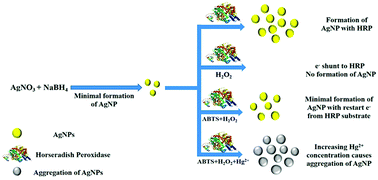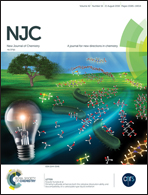Horseradish peroxidase-mediated in situ synthesis of silver nanoparticles: application for sensing of mercury†
Abstract
An indirect enzyme-induced in situ formation of silver nanoparticles (AgNPs) was investigated for the spectrophotometric detection of inorganic mercury (Hg2+) in aqueous solution. The enzymatic activity of horseradish peroxidase (HRP) assists the formation of AgNPs, which is prevented upon the addition of an excess amount of hydrogen peroxide (H2O2). On addition of the enzyme substrate 2,2′-azino-bis(3-ethylbenzothiazoline-6-sulfonic acid)diammonium salt (ABTS), the excess amount of H2O2 converts the ABTS into the radical cation (ABTS˙+), which could help in restarting the HRP activity for the formation of AgNPs. The addition of increasing amounts of Hg2+ (HRP inhibitor) in the reaction mixture resulted in the progressive inhibition of the enzyme activity and could cause AgNP accumulation. The morphological changes caused during the enzyme-induced formation of AgNPs were further studied by transmission electron microscopy (TEM). The developed probe achieved a good limit of detection 0.78 × 10−9 M and a limit of quantification of 2.6 × 10−9 M in aqueous solution. The probe also demonstrated high recovery percentages for Hg2+ spiked in environmental matrices, highlighting the importance of the developed probe.



 Please wait while we load your content...
Please wait while we load your content...